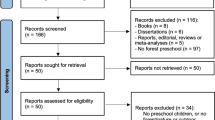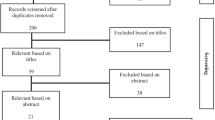Abstract
Keeping classroom animals is a common practice in many classrooms. Their value for learning is often seen narrowly as the potential to involve children in learning biological science. They also provide opportunities for increased empathy, as well as socio-emotional development. Realization of their potential for enhancing primary children’s learning can be affected by many factors. This paper focuses on teachers’ perceptions of classroom animals, drawing on accounts and reflections provided by 19 participants located in an Australian primary school where each classroom kept an animal. This study aims to progress the conversation about classroom animals, the learning opportunities that they afford, and the issues they present. Phenomenographic analysis of data resulted in five categories of teachers’ perceptions of the affordances and constraints of keeping classroom animals.






Similar content being viewed by others
Notes
Pseudonym
An amphibian also known as a Mexican salamander or Mexican walking fish
A fish also known as the Asian seabass, the Australian seabass, and the giant perch
References
Akerlind, G. (2005a). Ways of experiencing being a university researcher. In J. A. Bowden & P. Green (Eds.), Doing developmental phenomenography (pp. 145–155). Melbourne: RMIT University Press.
Akerlind, G. (2005b). Variation and commonality in phenomenographic research methods. Higher Education Research and Development, 24(4), 321–334.
Akerlind, G., Bowden, J., & Green, P. (2005). Learning to do phenomenography: a reflective discussion. In J. A. Bowden & P. Green (Eds.), Doing developmental phenomenography (pp. 74–100). Melbourne: RMIT University Press.
Alsop, S. (2002). Unweaving time and food chains: two classroom exercises in scientific and emotional literacy. Canadian Journal of Science, Mathematics, and Technology Education, 2(4), 435–448.
Anderson, R. D. (2002). Reforming science teaching: what research says about inquiry. Journal of Science Teacher Education, 13(1), 1–12.
Australian Curriculum Assessment and Reporting Authority [ACARA] (2015). Australian curriculum. Retrieved 18 September, 2015, http://www.australiancurriculum.edu.au/.
Bayne, G. (2009). Embracing criticality in science education. Cultural Studies of Science Education, 4, 559–567.
Bouillion, L., & Gomez, L. (2001). Connecting school and community with science learning: real world problems and school–community partnerships as contextual scaffolds. Journal of Research in Science Teaching, 38(8), 878–898.
Boyer, W. (2014). Using interactions between children and companion animals to build skills in self-regulation and emotion regulation. In Teaching compassion: humane education in early childhood (pp. 33–47). Dordrecht: Springer Netherlands.
Braun, A., Ball, S. J., Maguire, M., & Hoskins, K. (2011a). Taking context seriously: towards explaining policy enactments in the secondary school. Discourse: Studies in the Cultural Politics of Education, 32(4), 585–596.
Braun, A., Ball, S., & Maguire, M. (2011b). Policy enactments in schools introduction: towards a toolbox for theory and research. Discourse: Studies in the Cultural Politics of Education, 32(4), 581–583.
Campbell, C. (2012). Teaching approaches. In C. Campbell & W. Jobling (Eds.), Science in early childhood. Port Melbourne, Victoria: Cambridge University Press.
Daly, B., & Suggs, S. (2010). Teachers’ experiences with humane education and animals in the elementary classroom: implications for empathy development. Journal of Moral Education, 39(1), 101–112.
Department of Education of Western Australia. (2002). Using animals. Perth: Author.
Grundy, S. (1987). Curriculum: product or praxis? Philadelphia: Falmer Press.
Hackling, M., Smith, P., & Murcia, K. (2010). Talking science: developing a discourse of inquiry. Teaching Science: The Journal of the Australian Science Teachers Association, 56(1), 17–22.
Herbert, S., & Pierce, R. (2013). Gesture as data for a phenomenographic analysis of mathematical conceptions. International Journal of Educational Research, 60, 1–10.
Howes, E. (2008). Educative experiences and early childhood science education: a Deweyan perspective on learning to observe. Teaching and Teacher Education, 24(3), 536–549.
Hummel, E., & Randler, C. (2010). Experiments with living animals-effects on learning success, experimental competency and emotions. Procedia - Social and Behavioral Sciences, 2(2), 3823–3830.
Hummel, E., & Randler, C. (2012). Living animals in the classroom: a meta-analysis on learning outcome and a treatment–control study focusing on knowledge and motivation. Journal of Science Education and Technology, 21(1), 95–105.
Kaminski, M., Pellino, T., & Wish, J. (2002). Play and pets: the physical and emotional impact of child-life and pet therapy on hospitalized children. Children's Health Care, 31(4), 321–335.
Kincheloe, J. (2001). Getting beyond the facts: teaching social studies/social sciences in the twenty-first century. New York: P Lang.
Lewis, J. (2007). The significant life experiences (SLEs) of humane educators. Society and Animals, 15(3), 285–298.
Loughland, T., Reid, A., & Petocz, P. (2002). Young people’s conceptions of environment: a phenomenographic analysis. Environmental Education Research, 8, 187–197.
Lynch, J., & Herbert, S. (2015). Affirming irregular spaces in a school-wide curriculum initiative: a place for the animals. Curriculum Inquiry, 45(3), 285–303.
Marton, F. (1981). Phenomenography: describing conceptions of the world around us. Instructional Science, 10, 177–200.
Marton, F. (1986). Phenomenography—a research approach to investigating different understandings of reality. Journal of Thought, 21(3), 28–49.
Marton, F., & Booth, S. (1997). Learning and awareness. Erlbaum Associates: Mahwah N.J.
McInerney, P. (2009). Toward a critical pedagogy of engagement for alienated youth: insights from Freire and school-based research. Critical Studies in Education, 50(1), 23–35.
Meadan, H., & Jegatheesan, B. (2010). Classroom pets and young children: supporting early development. Young Children, 65(3), 70–77.
Morrison, A. R. (2009). An odyssey with animals: Veterinarian’s reflections on the animal rights & welfare debate. New York: Oxford University Press.
Nicoll, K., Trifone, C., & Ellery Samuels, W. (2008). An in-class, humane education program can improve young students’ attitudes toward animals. Society and Animals, 16(1), 45–60.
Rop, C. (2008). Cricket behavior. Observing insects to learn about science and scientific inquiry. American Biology Teacher, 70(4), 235–240.
Roy, K. (2011). Animals in the classroom. Science Scope, 34(6), 92–93.
Sadler, T. (2004). Informal reasoning regarding socioscientific issues: a critical review of research. Journal of Research in Science Teaching, 41(5), 513–536.
Sandbergh, J. (1997). Are phenomenographic results reliable?. Higher Education Research & Development, 16(2), 203-212.
Smyth, J., Angus, L., Down, B., & McInerney, P. (2008). Critically engaged learning: connecting to young lives. New York: Peter Lang.
Sorge, C. (2008). The relationship between bonding with nonhuman animals and students’ attitudes toward science. Society and Animals, 16(2), 171–184.
Svensson, L. (1997). Theoretical foundations of phenomenography. Higher Education Research and Development, 16(2), 159–171.
Svensson, A. (2014). The impact of the animals on children’s learning and their development—a study of what children learn from and with pets: the example of dog and cat. Children, 59, 77.
Wagoner, B., & Jensen, E. (2010). Science learning at the zoo: evaluating children’s developing understanding of animals and their habitats. Psychology & Society, 3(1), 65–76.
Wan, Z. H., Wong, S. L., & Zhan, Y. (2013). Teaching nature of science to preservice science teachers: a phenomenographic study of Chinese teacher educators’ conceptions. Science & Education, 22(10), 2593–2619.
Yoon, S. (2002). What children think about human-animal relationships: incorporating humane education goals in science and technology curriculum and instruction. Canadian Journal of Mathematics, Science & Technology Education, 2(4), 449–466.
Zasloff, R., Hart, L., & DeArmond, H. (1999). Animals in elementary school education in California. Journal of Applied Animal Welfare Science, 2(4), 347–357.
Author information
Authors and Affiliations
Corresponding author
Ethics declarations
Conflict of Interest
No conflict of interest occurs with this article.
Rights and permissions
About this article
Cite this article
Herbert, S., Lynch, J. Classroom Animals Provide More Than Just Science Education. Sci & Educ 26, 107–123 (2017). https://doi.org/10.1007/s11191-017-9874-6
Published:
Issue Date:
DOI: https://doi.org/10.1007/s11191-017-9874-6




